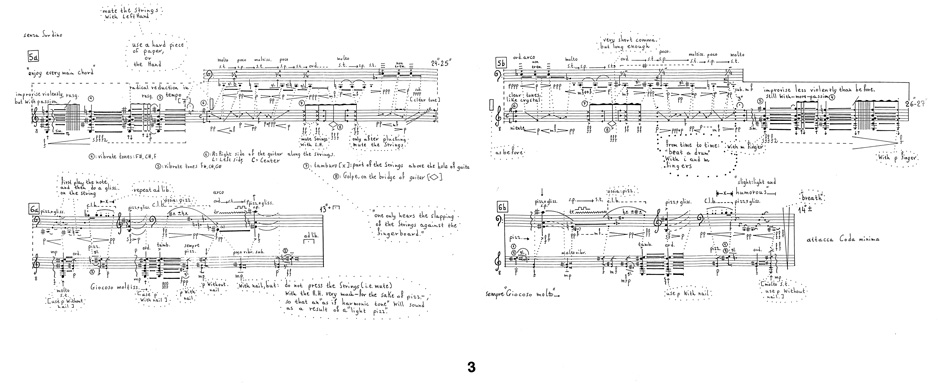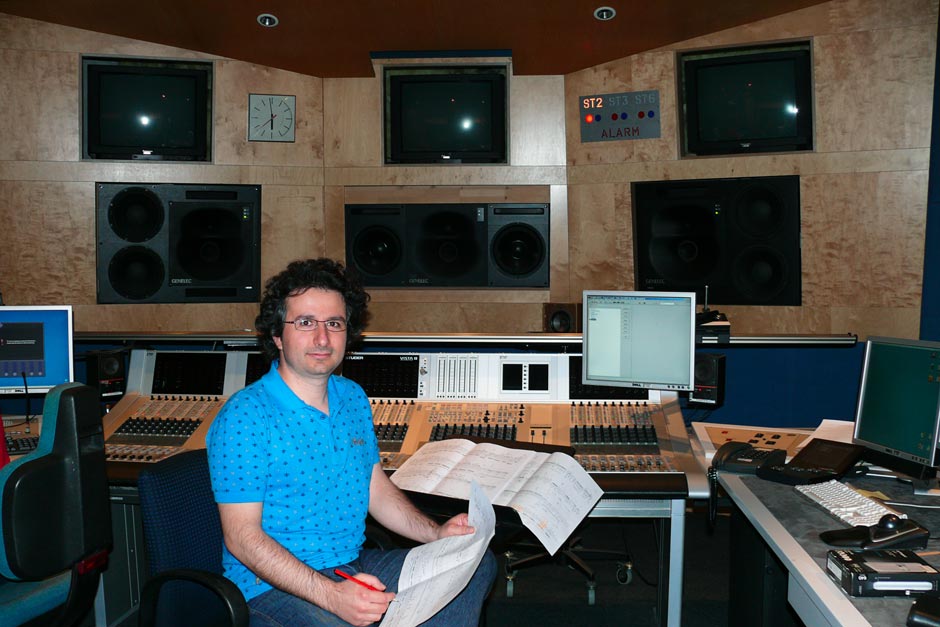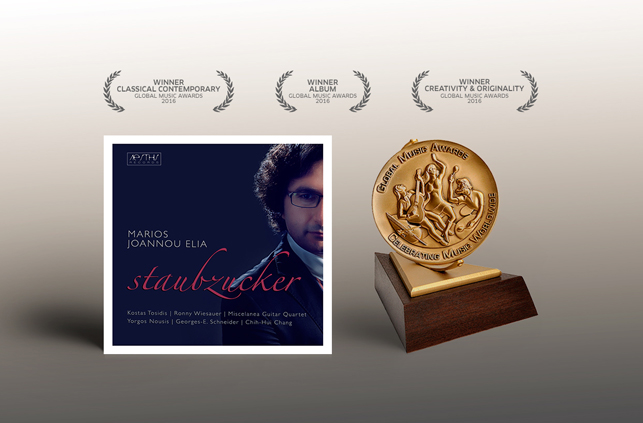

“Staubzucker by composer Marios Joannou Elia is an album filled with fascinating soundscapes and a wealth of compositional ideas. It explores the sounds and the endless possibilities of the guitar in chamber music making it a very significant contribution to the guitar repertoire.”
This is Classical Guitar, Canada
GUITAR ALBUM
_
[ABOUT] [ESSAY] [CREDITS] [PREVIEW] [MUSIC VIDEOS] [AWARDS]
ABOUT
A Groudbreaking Album of Guitar Music
Marios Joannou Elia’s new CD Staubzucker
_
Staubzucker is an alluring recording of nine works by the composer Marios Joannou Elia – 55 minutes of music, composed between 1999 and 2008, which adds new dimensions to guitar repertoire. The recording is neither typical contemporary music nor is it a mainstream classical guitar album, but it offers a manifestation of the endless possibilities of the guitar.
Elia studied the guitar with Marco Tamayo at the Salzburg Mozarteum and had masterclasses with Alvaro Pierri, Leo Brouwer and Aniello Desiderio; he studied chamber music with the violinist Rainer Schmidt of the Hagen Quartet. Up until the mid-2000s Elia was performing regularly in concerts across Europe and it is this specific musical background which has inspired his particular interest in composing music for the guitar in diverse instrumental combinations.
The compositional style of the works on this recording varies in terms of their musical substance and behaviour, expressing the composer’s distinctive musical values: his breadth of vision, technical craft, rhythmic drive, movement and gesture, and his profound expressivity and meta-theatricality, which have a spirit of restlessness and unexpectedness – often achieved through compositional techniques invented by Elia himself.
Characteristically, the instrumentation of the guitar within a mixed ensemble offers fresh perspectives and ground-breaking approaches to the presentation of his musical ideas. In With a Pair of Scissors and a Thousand Threads for violin and guitar, the guitarist simultaneously performs on two guitars. Cursed, which is for a classical and an electric guitar, develops on a single note, in stark contrast with Staubzucker for guitar quartet, where he transforms the guitar quartet into a percussion ensemble through the imitation of 23 different percussion sounds played on guitar, together with the addition of vocal elements.
The music on this recording is performed by virtuoso musicians who over many years have worked extensively with the composer: Kostas Tosidis, a specialist in Elia’s music (guitar); Ronny Wiesauer (electric guitar); Georges-Emmanuel Schneider (violin); Chih-Hui Chang (violoncello); Yorgos Nousis and Kostas Tosidis (guitar duo); and the Miscelanea Guitar Quartet, whose concert repertoire consistently includes Elia’s works.
The album, which was recorded at the ORF RadioKulturhaus in Vienna, will be released on 25 November 2015 and will be available through all the major online stores. It includes enlightening liner notes by the musicologist Dr Vera Grund of the University of Salzburg.
Essay
Marios Joannou Elia’s Music for Guitar
by Dr Vera Grund, University of Salzburg
_
There are nine pieces for guitar in Elia’s album Staubzucker, which takes its title from one of those works. In Between (1999), Soliloquy (2002) and Maneuver (2006) are for solo guitar. The remainder are chamber works: the guitar duet Ontologie Kubik (2001); two guitar quartets Apophis (2001/2008) and Staubzucker (2007); With a Pair of Scissors and a Thousand Threads for violin and guitar (2002); Im Spiegel for violoncello and guitar (2002); and Cursed for electric and classical guitar (2008).
Elia’s compositional style distinguishes him in several ways. He uses both conventional and unconventional playing techniques on partly-prepared and unprepared instruments, so that the overall pallet of sounds which he achieves is idiomatically innovative. The polyphonic perspective through which he approaches his writing means that a single instrument or a player could be perceived as performing chamber music. Furthermore, Elia’s music is characterised by complex rhythmic structures, which play a vital role in the development and aesthetic qualities in his compositions.
Above all, expressiveness remains a constant priority and Elia’s distinctive technique is simply a means to achieve this goal. His works are imbued with different timbres, leading to a subtlety of expression that can surprise the listener with their dramatic effects. In this way, together with his approach regarding musical structure and extra-musical meanings, Elia’s compositions connect with ancient dramatic art forms.
This collection of Elia’s guitar music offers an account of his multifaceted style between 1999 and 2008. While the exploration of novel ways to create sound was attempted in his earlier pieces, simplicity in the application of the material and musical devices has been the intention in the later ones – although, these have still been composed in a complex structural manner.

—
1. Ontologie Kubik (2001) is a guitar duet, featuring loosely aleatoric influences. Elia uses a cube as a base for his notation system, with different sequences notated on each side of the cube. The use of quasi-graphic notation, in combination with the cubic architecture and the option for change in its instrumentation – either for one or two guitarists – resembles aleatoric techniques. However, the composition is based on a determined succession of short episodes or events, with the musical instructions and playing techniques precisely described in an 18-page catalogue. Likewise, the pitch material is specifically notated, while duration and musical effects are approximately prescribed.
A powerful performance of the work is included on the recording by the Duo Nousis-Tosidis, who premièred the piece at the Schloss Frohnburg Palace, Salzburg in 2005. Ontologie Kubik won First Prize in the 2006 Savarez-Corelli Chamber Music Competition in Salzburg.
—
2. Soliloquy (2002) for guitar solo presents two qualities of particular interest. First, the piece combines the tremolo technique with the melodic and harmonic elements of jazz in short passages. Second, as the title Soliloquy indicates, it relates to the dramatic art of a monologue and, in this way, it can be considered as the expression of Elia’s personal relationship with guitar and his influences from other musical genres. In other words, it is a personal confession coming from the composer’s musical identity.
Soliloquy is often played by the Mozarteum lecturer Kostas Tosidis, who has performed the composer’s entire guitar oeuvre to date.
—
3. Im Spiegel (2002) for violoncello and guitar begins with a virtuosic introduction for solo violoncello, followed by six distinct episodes and a coda for both instruments. Initially, each of the three episodes appears in its original form and then afterwards in retrograde. This core compositional principle is reflected in the title of Im Spiegel, which means ‘in the mirror’.
The score does not use bar lines to define the time signature but instead gives graphic and optical signs regarding the duration of notes and the rhythmic units. Although the notation of the piece offers the performer freedom in its interpretation, the musical expression and harmony in each part are thoroughly defined and demand precise interpretation. Thus, freedom and determination become hidden musical meanings in the piece.
In 2002, the composer Marios Joannou Elia and the Mozarteum Professor Michaela Schwarzbauer premièred the work in Linz. Im Spiegel was awarded a commission by the International Society for Polyaesthetic Education.

 Excerpt from Im Spiegel for violoncello and guitar
Excerpt from Im Spiegel for violoncello and guitar
—
4. Apophis (2001/2008) – the Egyptian spirit of darkness, evil and destruction, who threatened to destroy the sun god Re – is inspired by Elia’s interest in ancient history. Written for guitar quartet, the composer mostly uses conventional playing techniques. The constitutive musical device consists of imitations and imitations in pretence. The quartet starts with two duets, while in the middle each guitar voice separates in a polyphonic style to create tension, signifying Apophis and chaos. In the second duet, the detuned lowest string represents destruction, as the near-Earth asteroid Apophis produces an anxiety that it might hit the Earth.
Apophis, which was funded by the Otto Mauer Fund Vienna, was re-commissioned for guitar quartet by the Miscelanea Guitar Quartet, who premièred it at the Aula Magna Rectorado of the Carlos III University in Madrid in 2008 – it was originally composed for clarinet quartet in 2001.
5. In Between (1999) consists of two movements: Tragedy and Elegy.
Tragedy starts with a lyrical ‘Entrée’, followed by the ‘Energetico’, ‘Marcia Funebre’, ‘Dramatico’, ‘Molto Patetico’ and ‘Misterioso’ sections, to finish dramatically. The divisions in its structure and expression reflect the form of classical Greek tragedy.
Elegy uses a closed form and its character is rather lyrical and nostalgic. Although the title of the piece portrays a lamentation, its music clearly delineates positiveness and specifically catharsis – that is, purification – which finally comes as a result of the tragedy. This is one of Elia’s most traditional compositions and displays his skills in developing melodies.
In Between was premièred by Dimitris Regginos at the Limassol Pattichion Municipal Theatre in Cyprus in 2001.

—
6. Elia’s compositional approach in Cursed (2008) indicates a kind of ‘new simplicity’ in his style. In contrast with the previously described works, here the development derives from extremely limited material. Elia maximises the reduction of the tonal material by using only one note: an E in different octaves and its enharmonic equivalents. Interestingly, although the interchanging sound colour of the two closely related instruments – a classical and an electric guitar – becomes its sole source, numerous new prospects are achieved. For instance, the use of the electric guitar allows the simulation of a bowed instrument with one crescendo note. The dynamic changes together with the velocity of the repeated notes generate tension. Apart from the challenges confronted by Elia in its composition, the piece itself is also demanding to perform.
Cursed was commissioned by the Cultural Funds of the Land of Salzburg and was premièred at the Gaudeamus Festival in Amsterdam in its solo version by Kostas Tosidis in 2008.
7. With a Pair of Scissors and a Thousand Threads (2002) was written for violin and one guitarist, who simultaneously performs on two guitars with an altered scordatura (i.e. using a different tuning from the standard for each guitar). In addition, the guitarist uses a capo, which raises the open-stringed pitch of all of the strings simultaneously.
Although the violin and guitar interact with each other and appear to be in a dialogue, they are unrelated, for their voices remain self-contained, independent and equal. Each part is divided into musical cells and motives and, hence, in ‘a thousand threads’. The loose internal connection of the different sections – such as ‘Intro’, ‘Interludium’, ‘Magic Dance’ and ‘Pseudo Coda’ – obliterates the listener’s memory and sense of time.
The original scoring for violin and two classical guitars included atmospheric percussion instruments performed by the guitarist. With a Pair of Scissors and a Thousand Threads was played by Amiram Ganz (Altenberg Trio) and the guitarist María Isabel Siewers at the Vienna Guitar Festival 2005 (ORF RadiokulturHaus). In the same year, an adaptation was made for two guitars, violin, double bass and two percussionists and was performed by Eliot Fisk’s ‘Guitar and Friends’ Ensemble in Salzburg.
When the première of the version for violin and one guitarist playing on two electric guitars was given by the New Music Society of the University of Cambridge in 2002, the Cambridge Varsity praised the composer’s ability ‘to create as rich an atmosphere of sound as possible with as few players’ (15 November 2002).
The version for violin and two classical guitars is the one performed by Georges-Emmanuel Schneider (violin) and Kostas Tosidis (guitars) on this recording.
Excerpt from Cursed for electric and classical guitar
—
8. Maneuver was commissioned by the Encuentros International Festival in Buenos Aires. It was premièred in 2006 under the title of La Caja in a staged version by the Argentinian actress Erica Pazur and the guitarist María Isabel Siewers. Starting with violent, dissonant chords followed by vivid tremolo passages and arpeggios, the atmosphere is calmed by a short interjection of dolce harmonics. Tension rises several times, generated by more percussive techniques such as rasgueado (strumming of the strings) and Bartók pizzicato, until the music disappears into silent infinity.
9. Staubzucker (2007) is a virtuosic work for guitar quartet that uses both the instrument and the instrumentalists to simulate percussion instruments. The performers are challenged to imitate the sounds of 23 different percussion instruments, through a complex and demanding score. Additionally, they create sounds via several unconventional techniques, such as performing on crossed strings, muting a string with the left hand and sliding the nail of the small finger of the right hand across the bass string, bilabial snaps and tongue clicks. These unconventional techniques provoke specific sounds, which create its theatrical and musical expressivity. It is a composition which demands high-level concentration in its performance.
‘Powdered sugar’ (Staubzucker in German) has a sweet taste, which is most often regarded as pleasurable. However, it can also be used in the production of highly explosive mixtures, which can bring about catastrophe. Likewise, the sirens – those beautiful creatures from Greek mythology, who played melodious songs to capture Odysseus – could become extremely dangerous and fatal. The idea that Sirens can be paralleled with powered sugar in terms of their bipolar meaning, that is, pleasure versus catastrophe, beauty versus death, led the composer to give the work this title. In this guitar quartet, the guitar becomes ‘ill’, and is almost ‘destroyed’, because instead of being used in its ‘traditional’, melodious way, it is treated as a percussion instrument. The composer was influenced by Horkheimer and Adorno in the Dialectic Of Enlightenment, ‘Since the happily hapless meeting of Odysseus with the Sirens, all songs have ailed’.
Staubzucker was commissioned in memory of Wolfgang Roscher, the former Dean of the Mozarteum University and was premièred in Salzburg’s Solitär Concert Hall in 2007. It has received over a hundred performances around Europe, in South America and in the United States and was described in a review by Classical Guitar Magazine as a composition ‘the performance of which one is not likely to forget’ (Steve Marsh, 2012).
Staubzucker is frequently played by the Miscelanea Guitar Quartet, who have won several international competitions performing it, such as the Competition for Contemporary Music in Salzburg (2008), the Chamber Music Competition in Thessaloniki (2008) and the International Guitar Competition ‘Luys Milan’ in Valencia (2008). [More about Staubzucker]
—
Related Bibliography: Vera Grund, Between Freedom and Determination: Marios Joannou Elia’s Music for Guitar, in: Perspectives of New Music, Vol. 53, ed. by Benjamin Boretz, Robert Morris, Hohn Rahn (Seattle, WA, 2015).
CREDITS
Recordings: ORF – Austrian Broadcasting Corporation, Funkhaus/Studio 2/PR2, RadioKulturhaus Vienna.
Guitar: Kostas Tosidis | E-Guitar: Ronny Wiesauer | Violin: Georges-Emmanuel Schneider | Cello: Chih-Hui Chang | Yorgos Nousis & Kostas Tosidis Guitar Duet | Miscelanea Guitar Quartet
Tonmeister: Andreas Karlberger, Friedrich Trondl | Recording Assistant: Stefan Wirtitsch | Editing & Mixing: Neo Kaplanis | Mastering: Deborah Spanton | Production: Nick Elia | Artistic Direction: Marios Joannou Elia | Editorial Contributor & Programme Notes: Vera Grund (University of Salzburg) | Photography: Aris Akritidis, Tomas HaluZss Kandus, Markus Sepperer, George Frangiskos, João Dinis, Kostis Nikolas | Design & Album Cover: Nikolas Kostis. Funded by ORF, SKE and Akademie Schloss Solitude.
With the contribution and support of Tanausu Luis Díaz (ex Miscelanea Guitar Quartet member), Gabriele Zanetti, Gisela Fürtauer and Nicole Potye (ORF RadioKulturhaus), Matthias Osiecki (ORF Ö1), Alector Guitars, Hannabach Strings and Ergoplay.
_
“Marios Joannou Elia’s Staubzucker offers a rare experience – a full recording of contemporary works for guitar solo and guitar in ensemble which one feels emotionally compelled to keep listening to from start to finish.”
International Classical Guitar, UK
_
PREVIEW
MUSIC VIDEOS
_
“An album that, at the same time, doesn’t seem the ‘typical’ Darmstadt contemporary music and is far away from the classical guitar records’ clichés”
Neuguitars, Italy
_
AWARDS
3 Gold Medals in 3 categories (Classical Contemporary, Album, Creativity and Originality) at the Global Music Awards 2016 in California.





